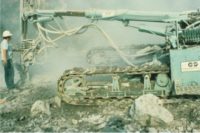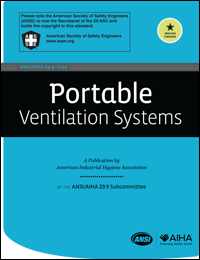AIHA submits comment on OSHA's proposed silica rule
February 4, 2014
OSHA Docket Office
Docket No. OSHA-2010-0034
U.S. Department of Labor
Room N-2625
200 Constitution Avenue, NW
Washington, DC 20210
Docket Officer:
The American Industrial Hygiene Association (AIHA) expresses its appreciation to the Occupational Safety and Health Administration (OSHA) for the opportunity to comment on the OSHA Proposed Rule on Occupational Exposure to Respirable Crystalline Silica. The Proposed Rule was published in the Federal Register on September 12, 2013, Volume 78, No. 177, beginning on Page 56274.
AIHA is the premier association serving the needs of professionals practicing industrial hygiene in industry, government, labor, academic institutions, and independent organizations. The AIHA mission is to promote healthy and safe working environments by advancing the science, principles, practice, and value of industrial hygiene. A healthy workforce is essential to the success of American industry, our economic recovery, and our future position in the global economy.
As stated by OSHA in the announcement of the proposed rule “Exposure to silica can be deadly, and limiting that exposure is essential. This proposal is expected to prevent thousands of deaths from silicosis as well as lung cancer, other respiratory diseases and kidney disease.” The agency currently enforces 40-year-old permissible exposure limits (PELs) for crystalline silica in general industry, construction and shipyards that are outdated, inconsistent between industries and do not adequately protect worker health.
OSHA develops proposed rules based on the best available published information. OSHA industrial hygienists, toxicologists, economists and epidemiologists use this information to examine risks posed by various exposure levels and identify feasible controls available through existing technology. The main issue at stake with this proposed rule appears to be the PEL.
AIHA believes the PEL needs to be based on scientific evidence and health effects as established by published National Institute for Occupational Safety and Health (NIOSH) and American Conference of Governmental Industrial Hygienists (ACGIH) documents, which conclude that the current PEL is inadequate and that change is needed.
More than any substance OSHA has regulated since asbestos and lead, silica has an extensive record of past health issues based on accumulated evidence of its hazards. Fortunately, the evidence also shows that feasible controls can be used to protect workers from silica.
As an organization, AIHA’s members and goals focus on preventing occupational illness and injury as a fundamental principle of the industrial hygiene field. AIHA also develops science-based public policy and practice through collaboration across scientific and technical communities, and works to ensure that safe and healthy environments are provided for all workers and communities. This focus needs to be maintained throughout this rulemaking process.
In the end, the question that must be answered is “will this proposal be better or worse for employee health and safety?” To this, AIHA believes the answer is a resounding “yes”, and AIHA supports OSHA efforts to move forward with the proposed rule.
AIHA comments on the proposed rule were drafted by several AIHA Volunteer Groups, including the AIHA Construction Committee, the AIHA Occupational and Environmental Medicine Committee, the AIHA Occupational and Environmental Epidemiology Committee, and the AIHA Exposure Assessment Strategies Committee.
AIHA Comments to Specific Questions Posed by OSHA
18d. Are OSHA’s estimates of exposure assessment costs reasonable?
For the compliance strategy cited, OSHA costs may be reasonable. But for a truly protective, accurately assessed exposure profile, they will be low. Explanation: The AIHA Exposure Assessment Strategies Committee (EASC) has developed a series of professional development courses over time that has drawn from the technical experts making up the EASC. An evaluation of exposure assessment strategies formulated to identify the risk of exceeding permissible exposure limits (as published by OSHA) or other occupational exposure limits (as recently pointed out by OSHA in their communication on this subject regarding the Annotated Tables) demonstrates that a compliance strategy based on the collection and analysis of a single sample is not suitable for understanding the exposure profile, as it is does not have statistical power to reliably detect exposures that would exceed the limit cited. Instead, the AIHA strategy has been shown to have superior power to detect exposures exceeding the limit, and that power comes from collection of a sufficient sample set, usually numbering from 6 to 10 samples, for demonstrating compliance to the limit. The OSHA Policy formulators are encouraged to consult the Exposure Assessment Strategies Committee information and Professional Development course content offered thru AIHA for more information.
37. The proposed rule defines “respirable crystalline silica”. Comments?
The OSHA proposed rule for Respirable Crystalline Silica establishes a Permissible exposure limit of 50 ug/m3. The proposed rule defines Respirable Crystalline Silica as: “airborne particles that contain quartz, cristobalite, and/or tridymite and whose measurement is determined by a sampling device to meet the characteristics for respirable-particle-size-selective samplers specified in the International Organization for Standardization (ISO)7708:1995: Air Quality-Particle Size Fraction Definitions for Health-Related Sampling.”
AIHA recommends that OSHA change the definition to read: “airborne particles of quartz, cristobalite, and/or tridymite and whose measurement is determined by a sampling device to meet the characteristics for respirable-particle-size-selective samplers specified in the International Organization for Standardization (ISO)7708:1995: Air Quality-Particle Size Fraction Definitions for Health-Related Sampling.”
The current proposed definition defines the entirety of a sample of dust containing any miniscule but detectable quantity of quartz, cristobalite or tridymite, as respirable crystalline silica. The proposed definition is more precise.
44. Is the wording of the two options for periodic exposure assessment understandable and clearly indicate what would constitute compliance? See page 548 thru 552 (d)(3)(i) and (ii)
NO. OSHA Field Operations Manual indicates that “compliance” decisions involve sampling data with incorporation of a sampling and analytical error. The standard does not address the use of SAE’s into the employer judgment. In addition, the performance option only calls for the use of data “sufficient to accurately characterize employee exposures”. Again, it should point to American Industrial Hygiene Association language on what an acceptable judgment of exposure can be based upon: number of samples for statistical validity, an acceptable tolerance for an error in that statistical judgment, and the connection of the sample set to a set of conditions occurring during the worker exposure measurement. AIHA data collection prior to training has demonstrated time and again the consistent errors made with professional judgments by industrial hygienists, without basing judgment on sampling, models, or other quantitative information. The odds that employers both with and without competent exposure assessment expertise could make these judgments accurately is very low.
54. Is exemption from exposure assessment PROCESS a good idea for those tasks found in the proposed Table 1 of the standard?
No. As previously identified, AIHA Exposure Assessment Strategies Committee experts have demonstrated that limited data sets will not sufficiently nor accurately characterize exposures over time. Hazardous materials management principles would dictate a need for continuing demonstration of the effectiveness of controls, consistent operator behaviors, and proper levels of respiratory protection. All of these are shown through the occasion of air monitoring, over time, for airborne silica.
56. Should employers working to control sets published in Table 1 of section (f) be required to comply with the PEL thru air monitoring provisions? (or paraphrased, Is the allowance for the employer to assurance exposure control without exposure monitoring a good idea or bad?
Compliance with the PEL should be required until sufficient data is assembled for the variability of workers, tasks and materials demonstrating exposure levels as acceptable (below), uncertain (indeterminate) or unacceptable (above) the Permissible Exposure Limit. A collection of sufficient data may come from an employer, an organization of similar business operations, and published as well as peer reviewed literature. Any of these could then serve as objective data sets. At such time as these objective data sets are available, then acceptable work practice and workplace controls can be assigned to tasks and activities. Once the performance of these controls are verified, then techniques such as work permits, job observations and workplace assessments can be conducted real time to see if the controls are being properly administered. Employers should be allowed to implement strategies other than monitoring, as long as they have researched the appropriateness of these strategies to control worker exposures below the permissible exposure limit, and have some mechanism(s) to assure that the strategies are working on a day-to-day basis.
54-68. Response regarding the use of Table 1 controls.
Discussion
The AIHA endorses the concept of Table 1 and the option it provides to construction contractors. AIHA encourages air monitoring as an important part of an overall worker exposure assessment program. However, the reality of construction sites is that things that impact the workers’ exposures such as:
• Specific work task being performed
• Duration of that task
• Materials being used
• Weather conditions
• Amount of natural ventilation
• Condition of work tools
• Surrounding activities
are constantly changing and therefore altering workers’ exposure. This can reduce the effectiveness of air monitoring in regards to determining proper worker protection procedures. In addition, air monitoring for determination of 8 hour time weighted average (TWA) results requires the samples to be sent off for laboratory analysis. Even in the best case situation, this can cause a delay of 2-3 days before results are available. Excessive exposures may have already occurred, tasks may have been completed, workers dispersed to other jobs and the usefulness of the monitoring results minimized. Use of Table 1 allows contractors to anticipate and implement protective measures from the start of the project and avoid the expense of air monitoring and its possibly minimal gain.
Table 1 also allows more ‘silica friendly’ job bid estimates. Table 1 allows contractors to anticipate what controls (and their expense and impact on production) will be required on the jobsite. This then can be factored into the job bid to produce a quote that will contain both time and money to allow management and workers to perform a silica safe job. This assists smaller contractors, who typically do not have dedicated safety professionals on staff, to avoid having to guess what may be required to properly protect their workers. While these controls and respirators may add cost to a job, it is a cost that can be accurately estimated and factored into the bid. This can also assist project owners in evaluating contractor bids to ensure there is proper forethought and moneys in the contractor bid for silica control.
Utilization of the Table 1 as a compliance option when respirators are required means the surrounding area must be considered a regulated area or under an access control plan. This combined with the engineering controls can help address the common problem of adjacent workers being inadvertently exposed to silica particulates. The need for a regulated area or control plan would now be an objective determination by the competent person. This in turn would help identify workers or areas where inadvertent exposure may occur and consequently allow procedures to be implemented to prevent this.
The AIHA also endorses the dual table format (i.e. less than 4 hours/greater than 4 hours duration). Many silica producing tasks on construction sites are of limited duration during a shift. This acknowledges that the limited duration of exposure on the jobsite provides a significant level of protection against silica (which has an 8 hour TWA PEL verses a STEL or ceiling level PEL). This in turn reduces the unnecessary use of respirators (including the expense) when the limited duration control provides an additional source of protection combined with the required engineering controls.
While AIHA endorses the use of Table 1 as a compliance option, there are several recommendations for OSHA to consider:
Looking for a reprint of this article?
From high-res PDFs to custom plaques, order your copy today!





